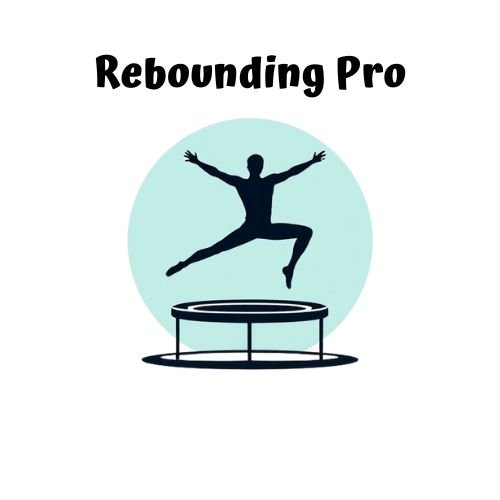Mini-trampoline jumps burn 6.9-12.4 calories per minute, with heavier individuals burning more (about 0.0278 calories per pound per minute). You’ll maximize calorie burn by increasing intensity—gentle bounces burn like brisk walking, while power jumps can torch up to 470 calories in 30 minutes. Track progress with a heart rate monitor, start with 5-10 minute sessions, and incorporate HIIT intervals for best results. The following tips will transform your rebounding routine into a calorie-burning powerhouse.
The Science Behind Each Trampoline Bounce and Calorie Burn

While it might look like simple fun, each bounce on a mini-trampoline triggers a complex chain of physiological responses that burn calories efficiently. Every jump requires your muscles to work against gravity, engaging in both pushing off and absorbing landings.
Your body burns between 6.9-12.4 calories per minute depending on your intensity. High-intensity rebounding can torch up to 470 calories in just 30 minutes—comparable to running at 8 mph. This happens because your heart rate elevates (typically 127-159 bpm), muscles continuously stabilize your body, and your lymphatic system activates. Trampolining also burns twice as many calories per minute when compared to traditional low-impact aerobic exercises.
What makes mini-trampoline exercise unique is the combination of muscle engagement with reduced joint impact. The elastic surface requires greater neuromuscular control than ground exercises, making each bounce more metabolically demanding than it appears.
How Your Body Weight Affects Calories Burned Per Jump
Your body weight directly impacts how many calories you’ll burn on a mini-trampoline, with heavier individuals expending more energy per jump due to the greater force needed to move their mass.
If you weigh more, you’ll typically burn more calories during your bouncing workout because your body must work harder against gravity with each repetition.
You can optimize your mini-trampoline exercise by adjusting your jumping intensity based on your personal weight, finding the sweet spot that challenges you without causing discomfort.
In our study, Alex burned significantly more calories than Sydney during identical workouts, supporting the conclusion that heavier individuals naturally achieve greater caloric expenditure on rebounders.
Weight-To-Calorie Burn Ratio
The relationship between body weight and calorie burn on a mini-trampoline follows a direct correlation—heavier individuals burn more calories per jump than lighter ones. This is quantifiable: you’ll burn approximately 0.0278 calories per pound of body weight each minute at recreational intensity, or 0.0613 calories per kilogram.
To calculate your personal burn rate, convert your weight to kilograms (divide pounds by 2.20462) and use the formula: Calories = (MET × weight (kg) × duration (minutes)) ÷ 200.
With trampolining’s MET value of about 3.5, a 30-minute session could burn between 125-160 calories for an average person. You can easily use a calories burned calculator to determine your exact energy expenditure without manual calculations.
Remember that your body composition matters too—higher muscle mass increases your metabolic rate, potentially boosting your caloric expenditure beyond these baseline calculations.
Heavier Jumpers Burn More
Body weight considerably impacts calorie burn during mini-trampoline workouts, with heavier individuals consistently burning more calories per jump than their lighter counterparts. This occurs because moving a larger body mass requires more energy expenditure, resulting in higher calorie burn rates. The ACE study clearly demonstrates this principle, showing that men (184 lbs) burned approximately 124 calories while women (142 lbs) burned about 94 calories in the same 10-minute rebounding session.
Studies show that a 208-pound person can burn up to twice as many calories as a 128-pound person during the same rebounding session. You’ll maximize your results by understanding how your weight affects your calorie-burning potential.
| Weight (lbs) | Low-Intensity (cal/30min) | High-Intensity (cal/30min) |
|---|---|---|
| 130 | 65 | 87 |
| 155 | 83 | 108 |
| 180 | 101 | 127 |
| 205 | 120 | 144 |
| 230 | 138 | 162 |
Personalized Jumping Intensity
Customizing your mini-trampoline workout based on body weight reveals critical insights into calorie-burning potential per jump. At a recreational level, you’ll burn approximately 0.0613 calories per kilogram of body weight each minute, meaning heavier individuals naturally burn more calories during identical routines.
To maximize your results, consider tracking your heart rate and adjusting intensity accordingly. Higher-intensity intervals can boost your burn rate to over 14 calories per minute, compared to 5.5-7 calories at moderate intensity for a 150-pound person. The formula calories = (MET × weight in kg × 3.5) ÷ 200 provides a scientific basis for estimating your personal calorie expenditure.
Remember that your individual metabolism creates variations even among people of similar weight. For precise calculations, convert your weight to kilograms and monitor your intensity levels consistently.
Intensity Matters: From Gentle Bounces to Power Jumps
When it comes to mini-trampoline workouts, intensity greatly affects how many calories you’ll burn per jump. Gentle bouncing engages fewer muscles and keeps your heart rate lower, similar to brisk walking in caloric expenditure.
However, shifting to power jumps that demand more vertical effort markedly increases your calorie burn from 12.4 calories per minute to 14.4 or more.
Power jumps dramatically boost calorie burn from 12.4 to 14.4+ calories per minute by requiring greater vertical effort.
- Moderate bouncing burns approximately 372 calories in 30 minutes
- Vigorous jumping increases to 432 calories in the same timeframe
- High-intensity rebounding can reach 470 calories, rivaling running at 8 mph
Your technique matters too—incorporate arm movements and vary your jump height to elevate intensity. A 150-pound individual will experience different caloric expenditure than someone weighing more or less during the same workout routine.
Tracking Your Mini-Trampoline Workout Efficiency

Accurately tracking your mini-trampoline workouts can transform how you approach your fitness routine and maximize calorie-burning potential.
While most fitness trackers don’t have specific settings for rebounding, you’ve got options.
Consider wearing a heart rate monitor during sessions to gauge intensity, or use fitness apps that allow custom activity entries. You can track approximately 9.4 calories burned per minute during an average rebounding session. Garmin watches, though lacking pre-set trampoline modes, can track through custom programming.
Don’t underestimate traditional methods either – maintaining a workout journal with duration, perceived exertion, and specific exercises performed provides valuable data over time.
Taking progress photos or regular body measurements can visually confirm your routine’s effectiveness.
Looking ahead, smart trampolines with built-in sensors and specialized apps may soon make tracking even more precise, helping you optimize every bounce for maximum efficiency.
Optimal Jump Duration for Maximum Calorie Expenditure
Finding your perfect jump duration means balancing time commitment with intensity level for maximum calorie burn.
You’ll see better results by incorporating interval strategies—alternating 30-second high-intensity jumps with brief recovery periods—rather than maintaining steady, moderate effort throughout.
As your stamina improves, gradually extend your total workout time from 10 to 30 minutes while maintaining these intensity variations to continue challenging your body. Depending on your body weight, you can expect to burn approximately 150 to 240 calories during a full 30-minute trampoline session.
Time vs. Intensity Balance
The balance between workout duration and intensity creates a critical equation for mini-trampoline enthusiasts seeking peak calorie burn.
While longer sessions naturally burn more calories, your intensity level often declines after 40 minutes, potentially reducing the calorie-burning effectiveness.
- 3-4 high-intensity 10-minute sessions throughout your day can burn more calories than a single 30-minute moderate session due to the metabolic “afterburn” effect.
- Adding arm movements or weighted resistance can boost your calorie burn by 15-20% without extending workout time.
- Your ideal duration sweet spot typically falls between 20-40 minutes, where you’ll maintain proper form while maximizing calorie expenditure.
Remember that brief, intense intervals (30-60 seconds) strategically placed within your session will accelerate calorie burn beyond what continuous moderate bouncing can achieve.
A person of approximately 145 pounds can expect to burn 5.6 calories per minute during moderate trampoline exercise.
Interval Jump Strategies
Strategic intervals on your mini-trampoline can dramatically increase calorie burn while keeping workouts engaging and time-efficient. For best results, structure your sessions using Tabata’s powerful formula: 20 seconds of all-out effort followed by 10 seconds rest, repeated for 4 minutes total.
Keep your high-intensity intervals between 20-40 seconds to balance maximum effort with proper form. Shorter 15-30 second bursts allow for peak intensity, while longer intervals should incorporate active recovery to prevent fatigue. Incorporating exercises like tuck jumps and jump squats during your 15-second intense moves can maximize calorie expenditure during shorter intervals.
Mix different movements within your intervals—combine basic hops with heel clicks and lateral bounces to engage more muscles and boost calorie expenditure.
For recovery periods, aim for half the time of your active jumps, and consider light bouncing instead of complete rest to maintain elevated heart rates and continuous calorie burn.
Progressive Duration Training
Progressive duration training provides a systematic approach to maximizing calorie burn on your mini-trampoline through gradual increases in jump time.
Begin with 5-10 minute sessions to establish proper form, then incrementally extend your workout by 2-5 minutes once you’ve mastered the previous duration.
For best results:
- Start with slower tempos (around 120 BPM) and increase by 10 BPM every two minutes
- Include 15-second recovery periods between tempo increases to maintain quality
- Aim for 15-20 minute sessions for intermediate levels, progressing to 20-30 minutes for advanced calorie burn
This approach balances intensity with sustainable performance, allowing your cardiovascular system to adapt while continuously increasing your caloric expenditure.
The progressive nature helps your joints and muscles acclimate to sustained impact, reducing injury risk while maximizing fat oxidation. Incorporating star jumps and straddle jumps as you advance helps engage different muscle groups and adds variety to your routine.
The Surprising Metabolic Benefits of Rebounding
Why does bouncing on a mini-trampoline create such remarkable metabolic effects? When you rebound, you’re not just burning calories—you’re triggering a metabolic revolution. Your body experiences increased gravitational force with each bounce, stimulating metabolism during and after your workout. This leads to extended fat loss through an elevated resting metabolic rate. Studies have shown you can burn up to 280 calories in just 19 minutes of rebounding exercise.
| Metabolic Benefit | How It Works | What You’ll Notice |
|---|---|---|
| Enhanced Calorie Burn | Higher expenditure vs. other cardio | Faster weight loss results |
| Improved Insulin Sensitivity | Better blood sugar management | Reduced cravings and hunger |
| Extended Fat Loss | Elevated post-exercise metabolism | Continued calorie burning at rest |
| Lower Metabolic Cost | Less perceived exertion for results | Sustainable exercise habits |
Rebounding also improves your body composition, making it an efficient way to transform your metabolism without overtaxing your system.
Comparing Mini-Trampoline Jumps to Traditional Cardio

When comparing mini-trampoline jumps to traditional cardio exercises, the numbers reveal a surprising efficiency advantage.
You’ll burn approximately 12.4 calories per minute during moderate rebounding, with that number rising to 14.4 calories during vigorous sessions—outpacing many traditional cardio activities.
- A 30-minute moderate rebounding session can burn between 165-372 calories, making it more time-efficient than steady-state jogging.
- Your body weight greatly impacts calorie burn, with heavier individuals burning more (about 0.0357 calories per pound per minute).
- High-intensity interval training on a mini-trampoline maximizes calorie burn while reducing joint impact compared to traditional cardio alternatives.
For ideal results, maintain moderate to vigorous intensity and customize your routine based on your weight and fitness goals.
Form Fundamentals to Increase Energy Expenditure
Five essential form elements can dramatically increase your calorie burn during mini-trampoline workouts. By focusing on proper technique, you’ll maximize energy expenditure while minimizing injury risk.
| Form Element | Energy Boost Effect |
|---|---|
| Proper Alignment | Maintains efficient energy transfer through your entire body |
| Knee Bending | Absorbs shock while activating larger muscle groups |
| Core Engagement | Stabilizes your jumps and recruits additional muscles |
| Foot Placement | Guarantees balanced weight distribution for sustained bouncing |
| Active Arms | Engages upper body muscles, increasing overall calorie burn |
Remember to keep your core tight throughout your session. Don’t let your posture collapse, even as fatigue sets in. Subtle movements with proper foot positioning actually burn more calories than high bouncing, which can strain your joints unnecessarily. By maintaining proper form, you’ll not only burn more calories but also protect your joints while enjoying longer, more effective workouts.
Creating a Progressive Rebounding Plan for Weight Management
With proper form established, let’s build a systematic approach to maximize your mini-trampoline results. An effective rebounding plan combines structured progression with adaptability to support your weight management goals.
Start with an 8-week program that gradually increases from 10-minute sessions to hour-long workouts as your endurance builds.
Begin with short sessions, gradually building to longer workouts as your stamina strengthens over eight weeks.
- Vary your routines between high-knees, twists, and basic bounces to engage different muscle groups and prevent fitness plateaus.
- Combine rebounding with strength training 2-3 times weekly for thorough body conditioning.
- Monitor your progress by tracking workout duration, intensity levels, and physical changes.
Remember to fuel your body appropriately with balanced nutrition and stay hydrated throughout your rebounding journey. Consider upgrading to specialized programs like bounti SCULPT once you’ve mastered the basics for targeted results.
Listen to your body and adjust your plan as needed, allowing for adequate rest between high-intensity sessions.
Incorporating HIIT Techniques on Your Mini-Trampoline
High-intensity interval training (HIIT) supercharges your mini-trampoline workout, maximizing calorie burn in less time than traditional cardio sessions. The formula is simple: 20-30 seconds of maximum effort followed by 10-20 seconds of gentle bouncing recovery.
Start with a 3-5 minute warm-up of light bouncing before diving into your intervals. Mix dynamic movements like high knees, jumping jacks, and hip twists to engage your entire body. Exercises like Criss-Cross Jack with a Tuck Jump offer an excellent intensity boost while working multiple muscle groups simultaneously.
Between each intense burst, recover with a basic bounce. For best results, use music or timers to maintain pace.
Begin with shorter intervals and longer rest periods if you’re new to rebounding HIIT. As you progress, increase intensity before extending workout duration.
The trampoline’s forgiving surface reduces joint impact, allowing you to push harder safely while still burning significant calories.
Frequently Asked Questions
Do Mini-Trampoline Workouts Burn More Calories Than Swimming?
Mini-trampoline workouts can burn more calories than swimming, especially during high-intensity sessions where you’ll burn up to 470 calories in 30 minutes. Your intensity level ultimately determines which activity burns more calories.
Can Seniors Safely Use Mini-Trampolines for Weight Loss?
Yes, you can safely use mini-trampolines for weight loss as a senior. Choose one with handlebars for stability, start slowly, and consult your doctor first. You’ll benefit from the low-impact cardiovascular exercise.
How Does Weather Affect Calories Burned During Outdoor Rebounding?
Cold weather boosts your calorie burn by increasing metabolic rate. Wind creates extra resistance, while altitude affects oxygen efficiency. You’ll need to adjust intensity and clothing for weather conditions to maximize benefits while rebounding outdoors.
Are Rebounding Calories Burned Different for Those With Existing Injuries?
Yes, your injuries can reduce calories burned during rebounding as they may limit intensity and duration. You’ll need to modify exercises, possibly workout for shorter periods, and focus on forms that don’t aggravate your condition.
Do Weighted Vests Significantly Increase Calorie Burn During Trampolining?
Yes, weighted vests considerably increase your calorie burn during trampolining. You’ll experience a 12-13% boost in calories burned as your body works harder to manage the additional weight during rebounding exercises.
In Summary
Your mini-trampoline isn’t just fun—it’s a calorie-burning powerhouse. You’ll maximize results when you track your jumps, vary intensity, and perfect your form. Remember, your weight and jump style directly impact calories burned. For best results, incorporate HIIT techniques and gradually increase session duration. Compared to traditional cardio, rebounding offers unique efficiency. Keep jumping consistently, and you’ll bounce your way to your fitness goals.





Leave a Reply